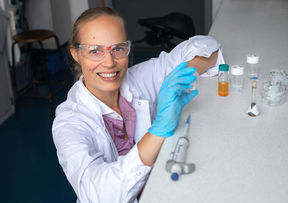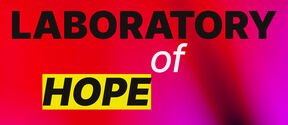Jaana Vapaavuori: From dancer to researcher

Professor Jaana Vapaavuori, what do you research and why?
I study functional materials. These materials react to an external stimulus. I am most familiar with the light-responsive materials. Basic research in physics and chemistry is most interesting to me, but if we are thinking of possible applications of functional materials, you could, for example, make remote-controlled, battery-free robots. In addition to light-responsive materials, I have recently developed other materials that react to light, such as new components for solar cells. But most of all I am fascinated by the basic questions of materials science.
How did you become a researcher?
When I was young I didn't think at all about becoming a researcher. I had long been focused on contemporary dance and even thought I could maybe make a profession out of it. However, after high school, I had to make a choice between dance and science, which I was also interested in. I was interested in all natural sciences, especially in the fields between chemistry and physics. Based on sensible reasoning and advice from older people I chose natural sciences, but dance has always stayed with me. During my studies, I led a dance group of eight male physicists and dancing is still my hobby. It would be great if I was able to combine these two things and, for example, to design some kind of active and functional components for dancers' costumes or performances.
What have been the highlights of your career?
I can’t really name any individual highlights. Naturally, I am satisfied with certain publications I have made or being able to bring some new perspective to the field of science. But I guess I could say that the most important highlights of my career have been moments when I have discovered something new.
What is required from a researcher?
It is a certain kind of persistence. Researchers also have to be able to deal with incompleteness and frustration because research does not create insights and results every day. When it comes to career structure and research funding we have to be able to deal with uncertainty. And despite the uncertainty, we must carry on focusing on the research.
The research world needs diversity. I myself do not feel like a stereotypical researcher and I hope to be a good role model for younger researchers. There is space and need for different personalities.
What do you expect from the future?
It would be great if I could influence major societal challenges such as climate change. No one can do this alone, but with my own work I would like to be involved in developing things in the right direction.
Because of its multidisciplinary nature, Aalto University has a very interesting work community, and I look forward to being able to work with researchers from different fields. For example, it would be interesting to work with artists to design dance costumes from a fabric which would react to movement, for instance by changing colour when it stretches.
Read more news

Join Unite's Well-Being Workshop Series
The interactive Zoom sessions are designed to support doctoral students’ well-being, strengthen a sense of belonging, and offer practical tools for success in their academic journey.Create your CV easily with the Research.fi profile tool
Aalto University’s researchers can now create a CV using the CV tool in the Research tool service. The tool generates an editable Word CV based on your Research.fi profile information, following the official TENK CV template.






